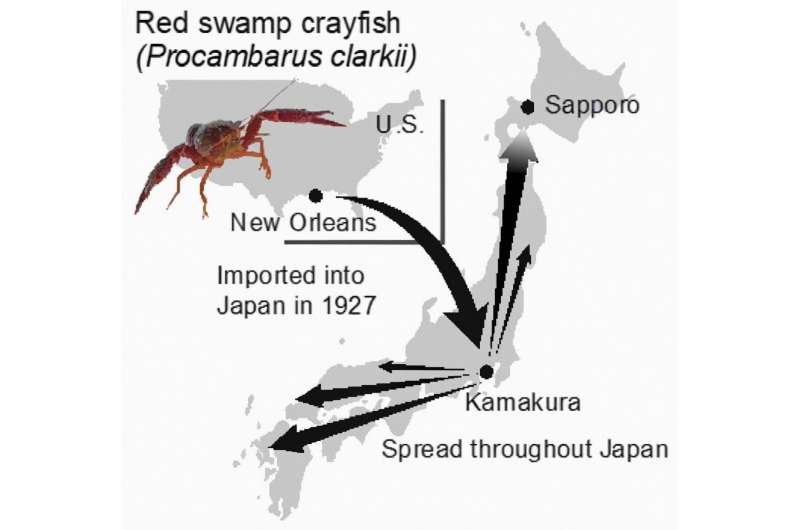This article has been reviewed according to Science X's editorial process and policies. Editors have highlighted the following attributes while ensuring the content's credibility:
fact-checked
peer-reviewed publication
proofread
How the tropical red swamp crayfish successfully invaded the cold regions of Japan

Owing to human activities and climate change, many animal species have invaded new habitats. Such biological invasion comes with devastating impacts on the local biodiversity and ecosystems. The red swamp crayfish—known to the scientific world as Procambarus clarkii (P. clarkii)—is no exception.
P. clarkii is a freshwater crayfish native to the tropical regions of southern U.S. and northeastern Mexico. After their introduction to different parts of the world, they have become one of the most widespread and invasive animal species. They are known for their adaptability and aggressive behavior that ensure their survival in a wide range of environments, even in regions much colder than their original habitats.
Given that P. clarkii is typically limited to subtropical climates, researchers have long endeavored to find a few P. clarkii populations in the colder regions of Japan. In Hokkaido, the northernmost island of Japan, P. clarkii populations have been observed in a limited number of rivers and ponds where water from hot springs or sewage treatment plants flows in and contributes to high water temperatures throughout the year.
A recent report, however, describes some populations settled in Sapporo City of central Hokkaido, where water temperatures become extremely low during the winter. A group of researchers from Japan, including Dr. Daiki Sato, Assistant Professor in the Graduate School of Science of Chiba University, and Professor Takashi Makino from Tohoku University sought to study the genetic changes that have allowed the crayfish to adapt to these cold environments.
Their study was published in iScience and was additionally selected and included in the journal's special issue, "Invasion Dynamics."
Speaking about the motivations behind their study, Prof. Makino, who led the study, says, "Although the red swamp crayfish has been a well-known and notorious invasive species in Japan for quite some time, nobody has examined its genomic and transcriptomic characteristics that contribute to its invasiveness yet, thus motivating us to pursue this study. We feel our study has far-reaching ecological implications."
Accordingly, the researchers studied P. clarkii from different populations in the newly colonized Japan and the originally inhabited U.S.. They compared differences in cold tolerance and related genetic characteristics among the samples. They also studied the effects of natural selection by comparing changes in gene sequences among the samples.
When asked about the main findings of the study, Dr. Sato, the first and co-corresponding author of the study, exclaims, "A population of red swamp crayfish in Sapporo, Japan may have acquired genetic changes that enhanced its cold tolerance. We have revealed the genes and genomic architecture possibly involved in the cold adaptation mechanism."
The researchers found that different P. clarkii populations, even within Japan, responded differently to the cold: some showed no significant changes in gene expression over time, while others displayed noticeable differences between the beginning and the end of the experiment.
Notably, they discovered regulatory changes in a group of genes involved in developing the protective outer layer of P. clarkii, called the cuticle. They also found an increase in the production of peptidase inhibitors—proteins that prevent the enzymatic degradation of proteins in the body. These peptidase inhibitors play a role in preserving protective proteins from being cold-damaged, thus contributing to cold resistance in P. clarkii.
Further, the researchers also found that some of the studied genes had undergone significant levels of duplication that resulted in a large number of copies of the same genes within the genome. This duplication may have amplified the genes' functional abilities in dealing with low temperatures.
These results provide valuable insights into the molecular mechanisms adopted by invasive species to develop cold resistance and survive in cold habitats. When used in the right context, these findings could have potential medical applications.
Overall, these findings significantly contribute to our understanding of invasive species, which may help us take measures to prevent their spread and, in turn, protect global biodiversity.
More information: Daiki X. Sato et al, Genomic adaptive potential to cold environments in the invasive red swamp crayfish, iScience (2023). DOI: 10.1016/j.isci.2023.107267
Journal information: iScience
Provided by Chiba University


















